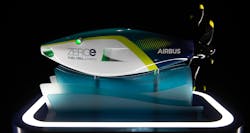Airbus Developing Engine Powered by Hydrogen Fuel Cells
Airbus reports it has started developing a new jet engine that would be powered by a hydrogen fuel cell, and that it expects to start ground and flight tests by 2028. The jet-builder added that it sees this conceptual propulsion system as a potential solution for zero-emission aircraft – which it has committed to introduce by 2035.
Testing will be done onboard Airbus’ ZEROe demonstrator – an A380 widebody aircraft designated as MSN1 – which is being modified to carry liquid nitrogen tanks and associated distribution systems.
According to Airbus, the promise of hydrogen fuel for combustion is that there are no carbon emissions, the only byproduct being water.
There are two ways hydrogen can provide fuel for aircraft propulsion: via hydrogen combustion in a gas turbine; or by using fuel cells to convert hydrogen into electricity in order to power a propeller engine.
A hydrogen gas turbine coupled with fuel cells instead of batteries is another option.
Airbus has been researching fuel-cell propulsion for several years, and in 2020 it initiated a research venture called Aerostack with ElringKlinger, a fuel-cell system developer.
That same year it proposed a concept involving six removable fuel cells to power propeller engine systems. Hydrogen fuel cells are considered to be scalable technology.
“Fuel cells are a potential solution to help us achieve our zero-emission ambition and we are focused on developing and testing this technology to understand if it is feasible and viable for a 2035 entry-into-service of a zero-emission aircraft,” stated Glenn Llewellyn, Airbus v.p. for Zero-Emission Aircraft.
“At scale, and if the technology targets were achieved, fuel cell engines may be able to power a 100-passenger aircraft with a range of approximately 1,000 nautical miles (1,850 km / 1150 miles.) By continuing to invest in this technology we are giving ourselves additional options that will inform our decisions on the architecture of our future ZEROe aircraft, the development of which we intend to launch in the 2027-2028 timeframe.”
